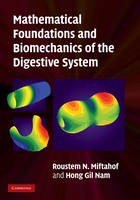
Mathematical Foundations and Biomechanics of the Digestive System
Cambridge University Press (Verlag)
9780521116626 (ISBN)
Mathematical modelling of physiological systems promises to advance our understanding of complex biological phenomena and pathophysiology of diseases. In this book, the authors adopt a mathematical approach to characterize and explain the functioning of the gastrointestinal system. Using the mathematical foundations of thin shell theory, the authors patiently and comprehensively guide the reader through the fundamental theoretical concepts, via step-by-step derivations and mathematical exercises, from basic theory to complex physiological models. Applications to nonlinear problems related to the biomechanics of abdominal viscera and the theoretical limitations are discussed. Special attention is given to questions of complex geometry of organs, effects of boundary conditions on pellet propulsion, as well as to clinical conditions, e.g. functional dyspepsia, intestinal dysrhythmias and the effect of drugs to treat motility disorders. With end of chapter problems, this book is ideal for bioengineers and applied mathematicians.
Roustem N. Miftahof is Professor and Head of the Department of Physiology at the Arabian Gulf University, Manama, Bahrain. He is a recognised leader in the areas of applied mathematics and gastrointestinal research, and has authored and co-authored two previous books in these fields. He has worked in both academia and industry across Europe, America and Asia. Hong Gil Nam is Professor at Pohang University of Science and Technology, Pohang, South Korea, Director of the National Core Research Centre for Systems Bio-Dynamics and President of the Association of Asian Societies for Bioinformatics. Professor Nam has received numerous awards for his research contributions and he has made several media appearances in South Korea.
Preface; Notations; Introduction; 1. Geometry of the surface; 2. Parameterization of shells of complex geometry; 3. Nonlinear theory of thin shells; 4. Continuum model of the biological tissue; 5. Boundary conditions; 6. Soft shells; 7. Biomechanics of the stomach; 8. Biomechanics of the small intestine; 9. Biomechanics of the large intestine; 10. Biological applications of mathematical modeling; Index.
| Zusatzinfo | Worked examples or Exercises; 189 Halftones, unspecified; 48 Line drawings, unspecified |
|---|---|
| Verlagsort | Cambridge |
| Sprache | englisch |
| Maße | 180 x 255 mm |
| Gewicht | 630 g |
| Themenwelt | Mathematik / Informatik ► Mathematik ► Angewandte Mathematik |
| Medizin / Pharmazie ► Physiotherapie / Ergotherapie ► Orthopädie | |
| Studium ► 1. Studienabschnitt (Vorklinik) ► Physiologie | |
| Technik ► Medizintechnik | |
| Technik ► Umwelttechnik / Biotechnologie | |
| ISBN-13 | 9780521116626 / 9780521116626 |
| Zustand | Neuware |
| Informationen gemäß Produktsicherheitsverordnung (GPSR) | |
| Haben Sie eine Frage zum Produkt? |
aus dem Bereich


